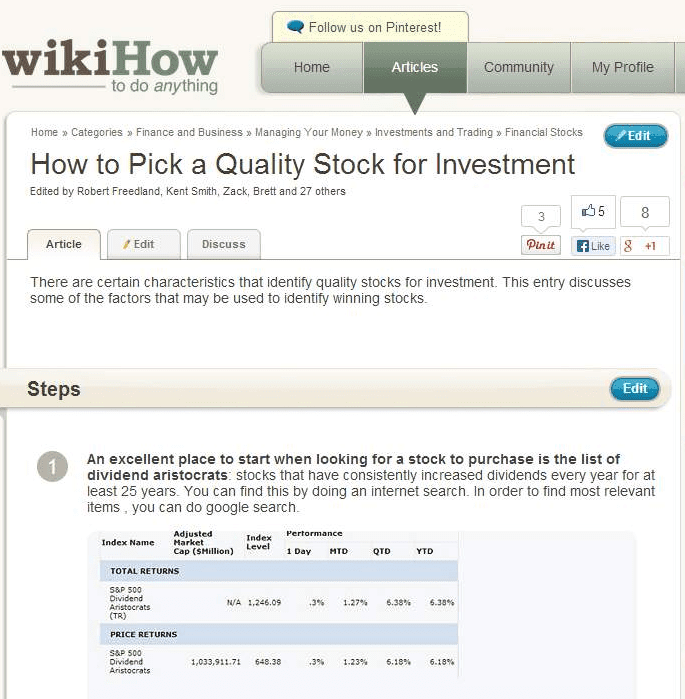Google makes hundreds of changes to its search algorithms every year. While most changes are minor and won’t have a significant impact on a site’s organic search performance, we have seen several changes and updates that are likely to affect how we plan, implement, and report on campaigns in the upcoming 2021 and beyond.
In this blog, we have taken a look at these recent changes in the SEO landscape and explained how you can best respond to them in your future campaigns.
What is in store for SEO in 2021
Google December 2020 Core Update to weed out low-quality YMYL content
On December 3rd, 2020 Google rolled out the December 2020 core update, creating a 7-month gap for website owners who were negatively impacted by the May 2020 core update to attempt to recover their traffic and rankings.
Later today, we are releasing a broad core algorithm update, as we do several times per year. It is called the December 2020 Core Update. Our guidance about such updates remains as we’ve covered before. Please see this blog post for more about that:https://t.co/e5ZQUAlt0G
— Google SearchLiaison (@searchliaison) December 3, 2020
This latest core update is a classic “broad core update” that Google releases every few months or so, and like all core updates, it was global and was not specific to any region, language or category of websites.
In the short-term, the timing of the update is likely to cause some devastating disruptions to certain businesses that make a lot of their sales right before the Christmas holidays. Also, early analysis shows major visibility drops and ranking volatility in Desktop search for health, real estate, travel, finance, law and government websites; and in mobile search for health, law and government, jobs and education, pets & animals, and real estate websites.
In addition, the most striking aspects of this update appear to be the dramatic reversal in visibility amongst several of the best-performing websites in 2020 such as Amazon, Pinterest, CDC, Overstock, CNN, New York Times, and other sites that greatly benefitted due to the coronavirus pandemic.
Pinterest decline in visibility after the December 2020 Core Update:

Amazon decline in visibility after the December 2020 Core Update:
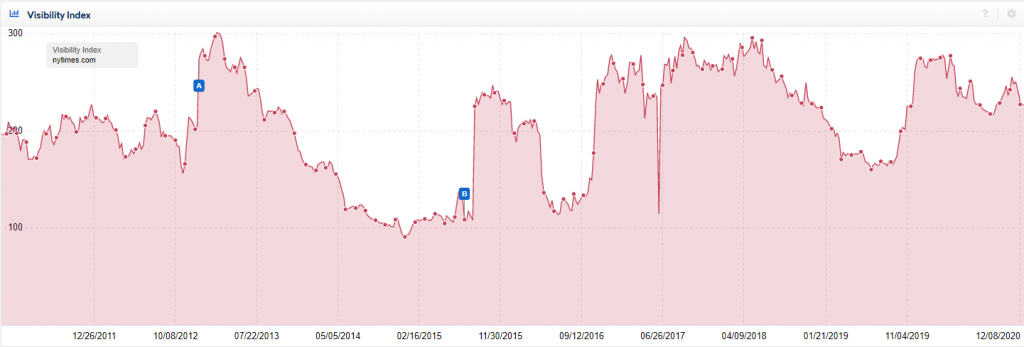
So what does this mean for you?
While it is still very early to make concrete conclusions on how this update will impact businesses in the long-run, one thing is clear – high-quality content that fulfills Google’s E-A-T (Expertise, Authoritativeness, and Trustworthiness) principle will be key in reversing the negative impact of this update and getting back in Google’s good graces.
This principle is especially relevant to business niches that fall under the “your money, your life” (YMYL) label, such as health care, law, and finance. As we highlighted above, these are precisely the industry categories that seem to be the most affected by Google’s latest core update at this stage.
According to Google’s Rater Guidelines, YMYL is a page or topic that gives advice to help people make an important decision or that “could potentially impact a person’s future happiness, health, financial stability, or safety”.
In other words, the stakes are high for this type of content as they can affect a person’s livelihood. When people turn to search engines, they’re looking for the best person to give them an answer that they can trust.
This means not only do you have to showcase your knowledge, but you also need to back it up with evidence. This is especially important for YMYL (Your Money or Your Life) pages in particular, as we stressed above.
To give more authority to what you are saying, you need to show the expert behind it; Google’s Rater Guidelines state explicitly:
“The reputation and E-A-T of the creators of the MC [main content] is extremely important when a website has different authors or content creators on different pages.”
Below is an example of a low-quality page where the writer does not have enough expertise and/or the website is not trustworthy in relation to the topic at hand.
They mention that “There is no evidence that the author has financial expertise.”However, since this is a YMYL topic, the author must have expertise in order to get a high-quality rating.
In stark contrast, this page on the same topic is considered to deserve a high-quality rating:
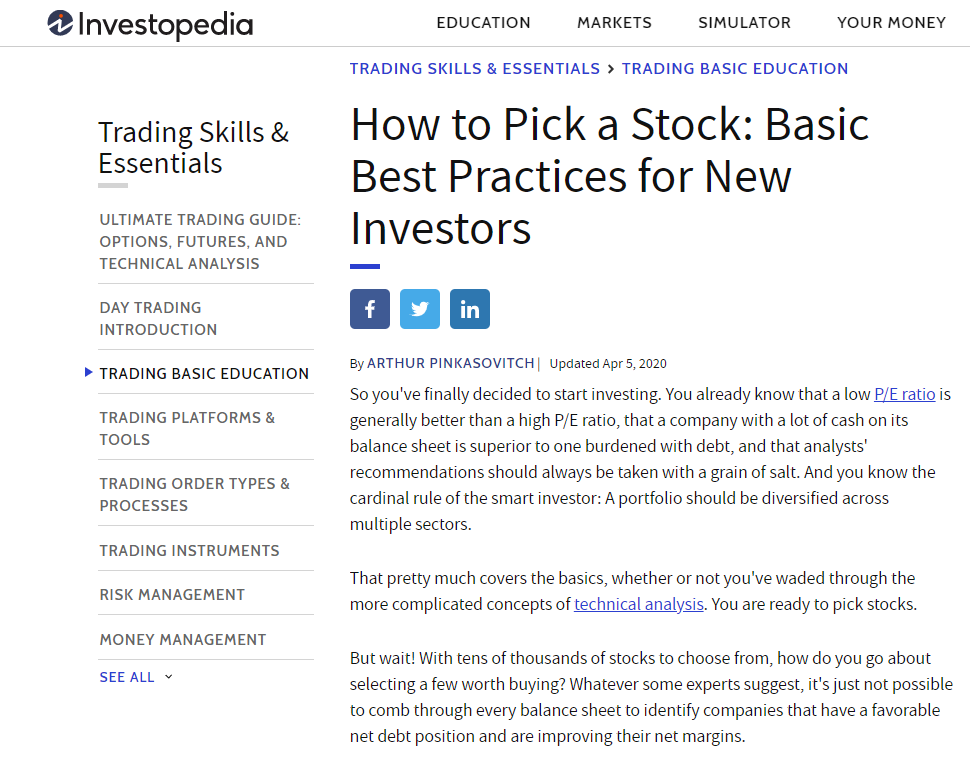
The page comes from an authoritative site in the financial sector, the article has a satisfying amount of high-quality main content on the topic at hand, and the author has proven expertise in the field as evident from his profile description.

To sum it up, this means that going into 2021, pages containing YMYL content will need to have specialised expertise behind them to ensure they send the right kind of quality signals to Google.
And while you can’t optimise for E-A-T because it is not an algorithm, you can implement the following few changes to help expand your reach and authority in the eyes of your users as well as in the search algorithms of Google:
- Gather positive reviews on various online platforms
- Backlink to and from authoritative sources
- Get mentions on forums and other authoritative websites
- Include author names & biographies for all editorial content: for blog posts, this means that information about the author needs to be available in order to evaluate whether they are a suitable expert for the topic at hand.
- Invest in Personal Branding through social media marketing to develop a positive reputation in your industry, connect with your online audience, and earn third-party endorsements.
- Edit/Remove low E-A-T Content
E-A-T Success Story: Medical site sees great gains after beefing up author E-A-T
This business is a UK-based specialist private health care provider. The client came to us after a strong hit connected with a Google quality update in 2017. When we began working together, their website was between development cycles and was not E-A-T or YMYL-friendly.
Most of the changes that we recommended centered around E-A-T:
- Adding author profiles to each of their posts. Each profile boasted about the author’s E-A-T and provided information on specialist areas, credentials, qualifications, awards, etc.
- Developing high-quality backlinks from authority sites in the health field towards the homepage and other key pages.
- Rebuilding the site’s content hierarchy to improve navigation and overall site architecture.
- Trimming out/optimising thin content that was not compliant with Google’s guidelines, and providing content templates to ensure all new content was E-A-T and YMYL-friendly.
- Implementing Medical / Doctor Schema.
- Taking advantage of any internal linking opportunities.
As a result, the client saw a significant uplift in organic traffic of 170% just within the first year of our partnership; since then their organic traffic has almost quadrupled, leading to massive improvements in their visibility and other KPIs.
Voice search will impact search queries
Current statistics show that in 2020, more than half of all smartphone users will engage with voice technology on their device. Moreover, the percentage of households predicted to own a smart speaker by 2022 is 55%. This suggests an enormous rise in voice search, as well as increased adoption of smart speakers.
Therefore, as voice search becomes increasingly popular, and connected devices keep adding and enhancing voice-enabled functions; marketers will have to regularly fine-tune their SEO strategy to optimise for voice search moving forward.
A good place to start from is by creating voice search FAQ pages. Why? Firstly, because a good chunk of voice searches are long, question-based queries. Also, a Backlinko survey found that Google prefers short, concise, and easy-to-read answers to voice search queries, with the typical voice search result being only 29 words in length.
FAQ pages check both of these boxes. That’s probably why voice search results are 1.7x more likely to come from an FAQ page compared to desktop results.
For example, if you do a voice search for “How do home insurance claims work?”, this is the result that comes up:
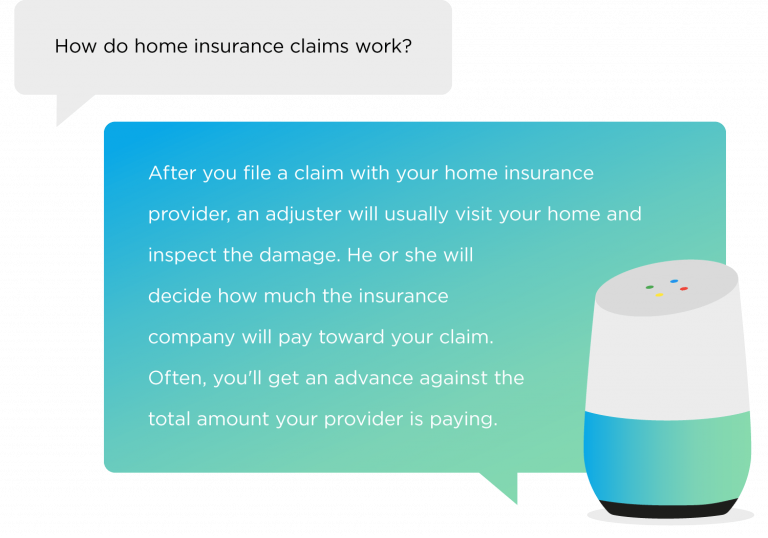
It appears that the source of this answer comes from this FAQ page:

This is just one of the many ways you can optimise your site for voice search queries. Here are a few more ideas:
- use natural or conversational language when writing content: with improved and reliable voice recognition systems, voice technology is well adapted to follow everyday language use.
- implement long-tail keywords because spoken language usually isn’t as concise as the written word, and you would need longer keyword phrases in order to secure a conversion.
- Use question words: start some paragraphs with questions, using “what”, “how”, “why”, “when”, as these words are more frequently used when users perform voice searches;
- Local information for your brand should be provided to meet the increased search volume for local businesses with voice.
Featured snippets will become more prominent
Featured snippets, which were rolled out in 2017, provide a brief summary of an answer to a search query and are usually displayed in a special box at the top of the SERP result, above paid and organic content.
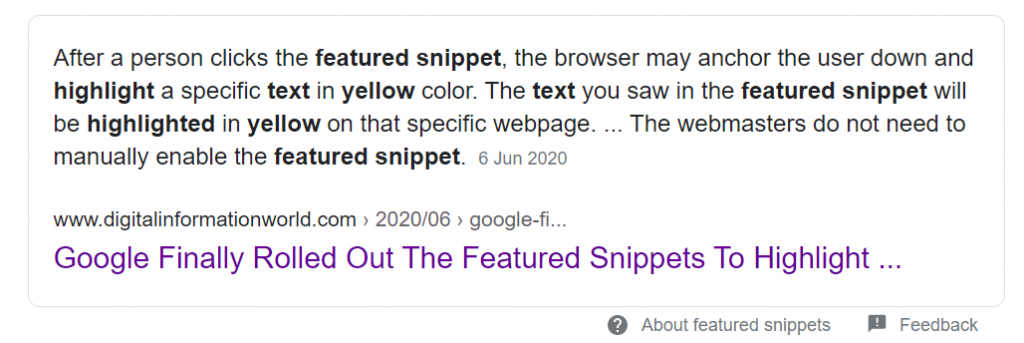
While featured snippets have been around for a few years now, they have been gaining more prominence lately since Google has started taking users directly to the answer. Instead of loading the webpage as normal, some browsers would now automatically scroll to the section of the webpage from which the content was taken, highlighting the text in bright yellow.
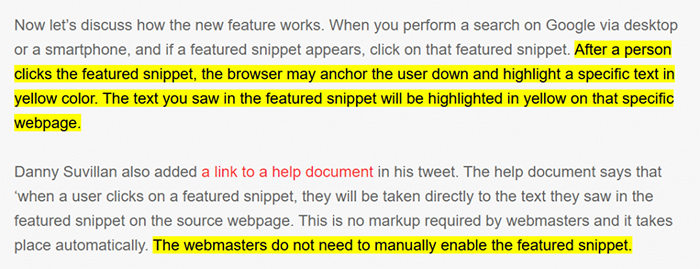 Although it is very useful and convenient for internet users, it is also detrimental to websites whose content does not make it to Google’s featured snippets. Data shows that around 55% of website clicks from Google’s search results pages come from featured snippets.
Although it is very useful and convenient for internet users, it is also detrimental to websites whose content does not make it to Google’s featured snippets. Data shows that around 55% of website clicks from Google’s search results pages come from featured snippets.
So if you’re able to get your content in the featured snippet, you can give your organic click-through-rate a serious boost. Furthermore, appearing in featured snippets can be extremely helpful for voice search SEO. According to a recent survey, 40.7% of all voice search results came from a featured snippet.
With all this in mind, it is, therefore, crucial to know how you can make it so that your website stands a better chance of appearing as a SERP feature going forward.
How to optimise for SERP features:
Most importantly, you would want to use words that are likely to generate featured snippets. A study by the STAT Search Analytics team revealed queries (grouped based on common themes) that returned snippets more often.

In the same study, results also revealed words that were less likely to rank in the snippets.

Other strategies you can work on include:
- Know the keywords your readers are using to ask questions (typically, inquiries that fall into the “how does”, “how to”, “how do”, “what is” categories).
- Work to provide the best answer possible: answer users’ questions in a brief form by breaking down each step in your answer and using visual content to back it up such as videos, infographics, and screenshots.
- Use schema markup and tag your products with schema alerts to optimise for rich snippets and make your site more appealing in SERP;
- Use Q-and-A pages featuring all relevant questions, where each is well-formatted with a complete answer.
Google my Business will play a larger role in local search listings
According to Safari Digital, 46% of all searches in Google have local intent. In addition to that, more than a billion people use Google Maps every month, and many of them do that to find businesses nearby, check their ratings, read customers’ reviews, find their contact information, and so on.
The pandemic has only served to accelerate these trends as people are searching for local businesses more actively, making Google My Business (GMB) a crucial part of any local search optimisation strategy. Without a well-optimised GMB listing, your chances of appearing in Google features like the Local Pack and Maps are going to be slim.
So, what does an optimised Google My Business profile look like? Before we get into our recommendations, let’s see what an optimised Business Profile looks like and versus an example of an incomplete and unoptimised one.
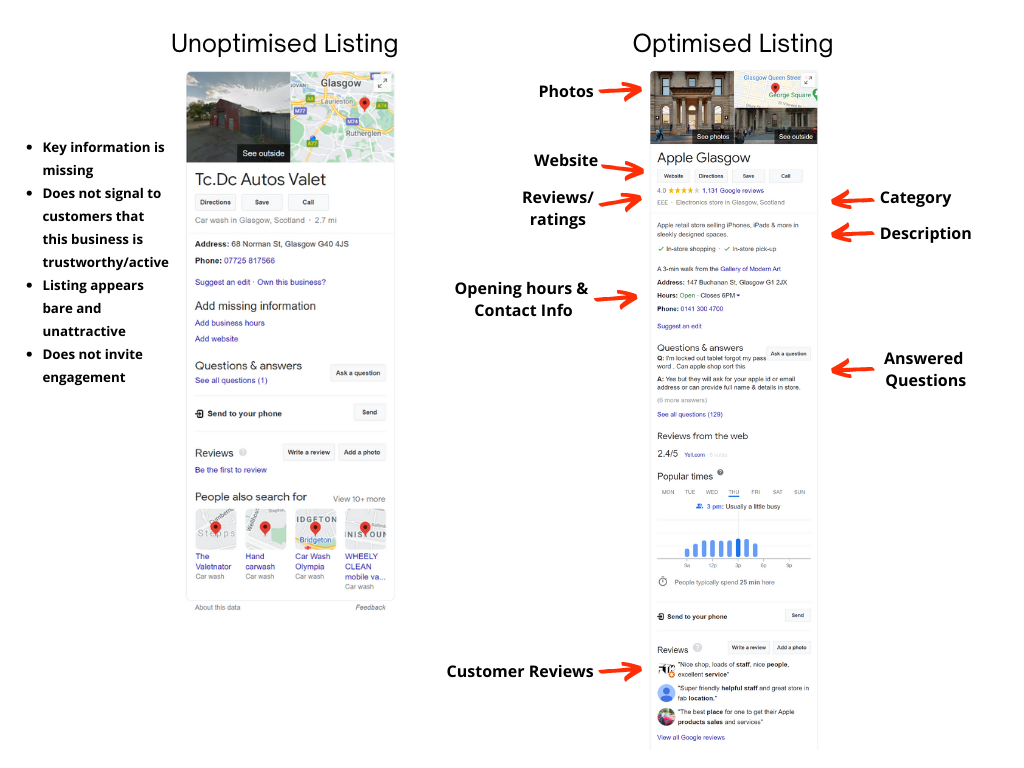
Here, the Tc.Dc Autos Car Wash Google Business Profile is a short box, but the Glasgow Apple store’s Business Profile would show even more when you scroll. When you compare the two, you can clearly see how much more attractive and engaging the optimised listing is, and that it definitely succeeds at building trust with the customers. Below you can find some useful tips on how you can achieve this for your own business as well.
How to optimise for Google My Business:
Once you have created a Google account, claimed your business, and verified it and its location, you should do the following:
- Set up users with proper access to your account.
- Optimise your business information (name, address, phone, opening hours, categories, etc.) and make sure to edit it as soon as changes happen.
- Add high-quality images, videos, and virtual tours.
- Add products, services or menu as appropriate.
- Write a complete, informative description;
- Pre-populate Q&A on your listing.
- Consider enabling Google Assistant and / or direct messaging.
- Consider enabling Reserve with Google if appropriate.
- Encourage, monitor and respond to reviews.
- Check and update your listing regularly.
- Get support for GMB questions, problems or suspensions.
Under-Optimised GMB Leaves Millions in Revenue on the Table
The local team at Boyd Digital helped generate millions in real estate agency fees via GMB phone calls, while working on a project for Countrywide PLC.
The project mainly focused on:
- Creating and tracking hundreds of local branch Google My Business profiles to ramp up visibility.
- Fully optimising all GMB accounts by populating them with clear and accurate business descriptions, location and contact information, and opening hours. (all of this appeared on Google Maps searches, allowing customers to quickly discover and contact the company).
- Encouraging customers to share their experience via reviews and ratings.
As a result, we were able to push competitors out of the Local Pack and increase Countrywide’s incremental sales.
If you have multiple business units and want to be best in your service areas, our local SEO team can help position your business to attract potential customers, increase your local authority and ultimately, grow your revenue. For more information, make sure to drop us a line in the form below.
Outstanding User Experience will become crucial to SEO
Along with high-quality content – which has been in the centre of the spotlight with every major Google update so far, you will also need great user experience (UX) in order to compete for the first positions in SERPs in 2021.
But why is UX so important? Well, it has been proven that even a 1-second delay in page load time can result in a massive loss for your business. In fact, Web FX stats show that “89% of consumers shop with a competitor after a poor website user experience”. The same study also tells us that “75% of website credibility comes from website design.”
In other words, no matter how good your content is, none of that matters if your web page doesn’t load quickly or if it has a complex user interface.
For the past few years Google has been moving away from solely ranking for search terms and is now seeking to provide users with the most relevant information that best answers their queries.
The introduction of RankBrain in 2015 was a significant step towards rolling out UX elements into SEO practices. RankBrain is driven by behaviour metrics, including pages per session, bounce rate, dwell time, and organic CTR. Essentially, these metrics inform Google whether you provide a good UX, and as a consequence, your ranking will either improve or worsen.
Furthermore, in 2019, Google rolled out mobile-first indexing, meaning the search engine looks primarily at the mobile version of a website, considering this the “primary” version instead of the desktop version. Having in mind that “72% of internet users will access the web solely via their smartphones by 2025”, this change makes a lot of sense.
We now also know that Google is set to launch another major update in May 2021 which is going to be geared towards providing more user-focused and user-friendly results by improving the UX on a particular page. When the Page Experience update goes live, Google said it will test various ways to display a “visual indicator” in the search results that will inform a searcher if a specific search result is expected to have a great experience.
Page experience is made up of several existing Google search ranking factors called Core Web Vitals. The Core Web Vitals are user-centered metrics that give scores on aspects of your pages including load time, interactivity, and the stability of content as it loads. As a result, the websites at the top of SERP will be much better from a technical perspective in the future.
In a nutshell, it is clear that optimising for quality user experience will be key to the long-term success of any website in the future.
What you can do about it
We know that Google’s May 2021 core update will combine Core Web Vitals metrics with Google’s existing signals to determine the quality of UX a certain page provides.
This means that downloading the “Web Vitals” Chrome extension would be a good idea. The extension is very easy to use and it provides instant feedback on loading, interactivity and layout shift metrics.
In addition to this, you also shouldn’t forget to regularly check how quickly your webpages load through Google PageSpeed Insights. The tool will provide you with information about your site’s performance for desktop and mobile devices and show you useful tips on improving it.
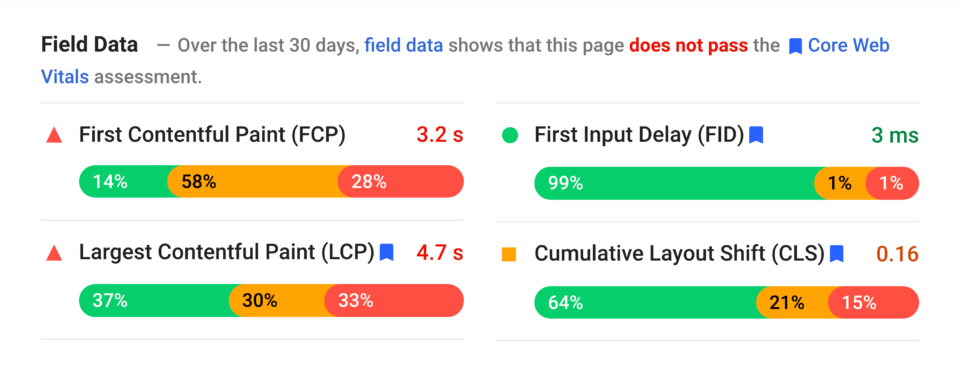
Media-rich content will become even more popular
Following on from the rise of video optimisation for web and video marketing, media-rich content such as video and imagery (either photography or infographic-style images) will play a significant role in SERPs in 2021.
According to a Forrester Research, video is 50 times more likely to show up on the first page of SERP than a web page with plain text. If it’s not enough, 62% of Google universal searches include video.
In general, videos are also believed to increase the time users spend on your website before bouncing out (dwell time), which is a key UX element and also an important metric that offers a great insight into the satisfaction of the web searcher. We expect search engines to place more crucial value on dwell time in 2021.
How to use media-rich content in your SEO strategy:
Adding product videos is perhaps the most common way that online retailers utilise video in their SEO strategy to increase conversions. According to Invodo, 52% of consumers say that watching product videos makes them feel more confident about going ahead and making a purchase.
 This can be especially true for big-ticket purchases such as the Shark vacuum cleaner above, where the sleek product video serves to reassure the customer of the quality and value of the product.
This can be especially true for big-ticket purchases such as the Shark vacuum cleaner above, where the sleek product video serves to reassure the customer of the quality and value of the product.
When it comes to service-focused businesses, explainer videos can be very effective in increasing conversions. For example, Dropbox found that they increased their conversion rate by over 10% by adding this video to their homepage. With their homepage receiving over 750,000 visitors a month, this means that the video helped to increase signups by several thousand every day and no doubt generated a huge ROI.
Here are a few ways you can start using video and imagery in your own SEO strategy:
- Use high-quality, relevant images on your website.
- Add alt tags to your images and customise the file name, labeling the photo file so that it’s relevant to the content on the corresponding page.
- Add images to your site map, where they are even easier to crawl.
- Create a business YouTube channel and post videos regularly because YouTube recommends videos from active content makers.
- Design videos with a specific goal in mind and don’t forget to include Calls-to-Action.
- Embed videos on your website.
- Create high-quality thumbnails to encourage people to click on your videos.
- Add key information for SEO: target keywords in the tags, links, description, and title to make it easier for users to find your content.
- Analyse your performance, and plan future content.
Don’t Let Your Video Work Go to Waste
With over 30 million regular daily users, YouTube is the world’s largest video hosting platform and also, the world’s second biggest search engine after Google. Using YouTube for your business can help you appear in Google top SERPs, increase your audience, drive traffic to your website, and help your business be found by people who are searching for your services.
However, in order to see any results, your videos must be optimised.
Here at Boyd Digital, our SEO experts make sure your lovingly created video content generates the conversions, traffic and views it deserves.
We are experienced at safely integrating large video libraries with your websites while applying the relevant Schema and ensuring site speed is not affected. By combining the right video content with our advanced search engine optimisation practices, we can drive millions of Channel views and a constant stream of click-throughs.
Conclusion
To sum it up, trends are changing day by day. This means that you can’t just optimise your website once and stay on top of SERP forever. SEO is an on-going process that requires a lot of effort and regular improvements.
So, as we move towards 2021, make sure you go through this checklist:
- Prioritise high-quality content by applying Google’s E-A-T principle where appropriate.
- Take advantage of existing SERP features by optimising your content.
- Optimise your site for voice search.
- Create a Google My Business account if you have a local company with a physical location and make sure to update it regularly.
- Measure your website’s user experience by using the new Core Web Vitals metrics.
- Incorporate media-rich content into your SEO strategy.
Though it may not be an overnight change, it is essential to start working on your SEO now, so your website will have better chances to rank higher in the upcoming year.
If you’d like support in responding to Google’s latest updates and SEO changes, our team can help you prepare an effective SEO strategy for 2021 that addresses your business’ unique needs.
For more information, please contact our team today!


